Business
Who Does Tori Dunlap Think She Is?
Published
3 years agoon

If you haven’t heard of Tori Dunlap, you’re probably not seeking financial advice. If you are seeking financial advice, you can do a lot better than Tori Dunlap.
Tori Dunlap is an entrepreneur who claims to have saved $100,000 by the age of 25. After achieving such astonishing success so early in life, she simply had to quit her corporate job so she could devote her energy to helping women learn their financial independence and unassumed dominance in our white cis male-run society.
Her mission? To create the brand HerFirst100K and…
Idk man… seems kinda gimmicky.
Disclaimer: I am a cis white male with no financial expertise to speak of criticizing a cis white female financial pundit. I have zero doubts that Dunlap could balance a checkbook better than I ever could. I am not here to offer any financial advice. Rather, I am criticizing Dunlap’s approach to fiscal responsibility and her overall authenticity.
In short: We’re not buying it and neither should you.
How Did She *Really* Get $100K by 25?
At 25, I was working as a barback in a local gay bar and on the cusp of starting my first professional writing job. I had maybe $600 to my name and very poor financial instincts – you could call me a ‘spendthrift.’
My peers around the same age were all fairly financially inept or carefree. Sure, we would meet our responsibilities but we sure as hell weren’t saving – and not for lack of trying. We all worked incredibly hard, dirty, thankless jobs for very little money and could be fired on a whim. None of us would have been able to save up to $100K by 25.
By 25, I had been working steady jobs for 10 years. Even if I didn’t spend a single cent over those 10 years I don’t think the number would have ever reached $100K. Pardon my doubts, but how is a 25-year-old, any 25-year-old, able to save up to $100,000 all by themselves? After some digging, it turns out she did it with a lot of discipline and a lot of luck.
She graduated college with zero debt, landed a job in digital marketing with a salary of $55K/year, and put a disciplined percentage of her take-home into saving and an investment fund. These are all great, very privileged ways to save $100,000 in three years.
I’m curious to know how a 22-year-old snagged an investment fund and knew which investments would pay off and how much they earned but… I digress.
I don’t sneeze at this kind of discipline. Many people would benefit from a financial discipline such as that. I do sneeze a little by using this as a marketing tactic. While she qualifies this by admitting her privilege, she makes her achievement the main marketing point of Her First $100K.
“I did this and so can you!” the sentiment screams. Except most people can’t. And I think Ms. Dunlap knows that.
Tori Dunlap Is Not Qualified To Give Anyone Financial Advice
The only thing I trust Tori Dunlap to do is market and brand herself effectively. She’s cool, she’s hip, she can play along with the broader trends, she TikToks with the best of ‘em, and it all feels so desperately empty and deeply phony.
I think Tori Dunlap has a keen eye for self-promotion that masquerades as “woke financial advice.” This would be fine if it wasn’t potentially f*cking with people’s money. There are people out there with some serious financial issues and concerns. If they trust Tori Dunlap, they could be misled because she doesn’t know what she’s talking about.
I don’t mean she doesn’t know how to assert her value and practice financial discipline. I mean she doesn’t have the financial authority to be profiting off the advice she gives. It’s like getting medical advice from a sickly friend – they’ve got experience but no expertise.
TikTok Advice Isn’t Real Advice
If you take a look at Dunlap’s TikTok, it looks pretty much like every other TikToker out there. On her page, the financial advice is few and far between. It appears that TikTok is the space where she promotes her brand, podcast, and book – with a whole lot of cookie-cutter trends you will find on any account.
When you finally do get to her financial advice, it’s no different than if you were to ask your fiscally savvy friend. For example, “know your worth and advocate for it” is a great bit of advice, it’s one I tell my peers at work – but it’s not expertise. It’s a good ol’ fashioned, “you can do it!” Which is nice, but it’s not practically helpful. What you’re getting from Dunlap are educated tips from someone who is being nice to you.
When you present yourself as an authority figure you have a responsibility that comes with it. Telling people you are the savior from the patriarchy if you pay for her course doesn’t exactly scream “hero.”
There’s nothing wrong with providing a service and charging for it. There is, however, something really gross about masquerading as a feminist hero when you’re actually an unqualified financial nobody with no serious credentials to speak of.
Tori Dunlap is not qualified to be giving financial advice to anyone. She says so on her site:
“LEGAL STUFF: I am not a licensed financial advisor. I offer education, not prescriptive advice. The information that is found here are my opinions and the opinions of other readers/contributors and should be taken as such.”
“Legal stuff.” Cute, so relatable.
All of Dunlap’s success stories are social media posts, texts, and emails. Hardly a case study.
Dunlap claims to be “leading a movement of financial feminists,” but a quick Google search on female financial advisors yields no results for Ms. Dunlap. What exactly is she leading? You cannot be a leader when you don’t show up on the first 12 pages of Google.
Here’s What An Actual Financial Expert Says
We spoke to Danetha Doe, an economist with over 10 years of experience in the financial industry. She has worked as an accountant and a CFO. She also created Money & Mimosas, a financial education resource for ambitious folks.
In short, Ms. Doe knows her sh*t.
We asked Ms. Doe about how the average person could save up to $100K by the age of 25.
“I don’t think it’s reasonable to believe the average person can save $100K by 25.
“In order to do that, they would either need to be born into wealth, have zero student loans, work for a startup that goes public or gets acquired, or start a business that is financially successful.
“All of those scenarios do not apply to the average person.
“The median salary for an individual is under $40,000. Therefore, the average person earns about $40,000. In order to reach $100K in savings on an average salary could take decades in the United States.”
Ms. Doe has a lot of excellent financial advice without being patronizing or weaponizing oppression for profit. She has a professional and personal background that makes her an effective authority when it comes to fiscal responsibility.
“My two grandmothers [are the financial experts I admire most].
“They came to the United States as immigrants and became real estate investors during a time when Black women were systematically shut out of wealth-building opportunities in this country.
“Their lasting legacy guides my financial decisions.”
If you want to learn finance tips from someone who can relate to or understand your experience fully, Danetha Doe is the way to go.
Besides, who doesn’t love a mimosa?
What In The Hell Is ‘Feminist Financial Advice?’
What is it about financial advice that needs to be tailored specifically for women? Let’s take a super casual and lazy glance at successful women, shall we?
Suze Orman is a trusted financial authority and has been around for a minute.
Madonna has built herself an entertainment empire by being unapologetically female.
Rihanna became a billionaire through her music and some super-savvy business moves.
Laverne Cox bulldozed expectations and helped establish a foundation for trans artists.
Sheryl Sandburg is the most powerful woman in Big Tech – did you see what happened when she resigned from Meta?
There is no shortage of female financial advisors. What kind of niche does Dunlap think she’s tapping into? Dunlap says on her site:
“I watched female friends get paid less than they were worth. I read stories about women being denied career opportunities because they were seen as ‘less.’
“Male colleagues said sexist, negative comments to me at work. I learned that women hold the majority of debt in America and that they invest less of their money than men, yet live for seven years longer.
“So I knew that I had to fight back.”
Sure, Jan.
Fighting Sexism By Leaning Into Sexism
I don’t think anybody disagrees (save for a few members of the Republican Party) that women have a tougher go of it than men. To be honest, it’s a bit of a stretch to connect general sexism with financial education. I learned how to budget from my mother, a woman who has had to fight her own battles with sexism and misogyny as the only female partner at her law firm.
Frankly, I think the assumption that women need help from an unlicensed non-expert in order to learn fiscal responsibility is teetering on sexism. At the very least, it’s grossly condescending and certainly inauthentic.
If you’re in a position where you need financial advice, you want it from someone who is a serious advisor, not a trending influencer with no qualifications. With inflation at a 40-year high and an underpaid workforce fighting for its value, we cannot afford to take financial advice from someone clearly more interested in self-promotion and branding.
Dunlap appears to be less focused on offering genuine financial advice and far more focused on hitting woke buzzwords in an effort to patronize marginalized communities for profit. If you want to find a female-focused financial authority, try Ellevest instead.
Tori Dunlap’s Communications Lead declined to comment.
Chris Blondell is a Philadelphia-based writer and social media strategist with a current focus on tech industry news. He has written about startups and entrepreneurs based in Denver, Seattle, Chicago, New Haven, and more. He has also written content for a true-crime blog, Sword and Scale, and developed social media content for a local spice shop. An occasional comedian, Chris Blondell also spends his time writing humorous content and performing stand-up for local audiences.

Business
Top 10 Best Places to Buy a Mid Century Modern Office Chair
Published
2 weeks agoon
July 4, 2025
What was once old is new again: mid century modern is back in style. From architecture to furniture, the postwar look is in, and the hype extends all the way to office chairs.
Do you need a mid century modern office chair in your life? If so, there’s plenty to choose from. Your office chair should be tailored to your style, whether you like luxury, utility, or something in between.
That’s why we’ve put together our 10 favorite places to find your ideal mid century modern office chair.
What is mid century modern design?
After World War II, spirits were high in the US, and new technology was taking the country by storm. Mid century modern refers to the design concepts that came about during this time.
As opposed to the frilly, ornate designs of classical furnishings, mid century modern designs are angular, material, and functional. Wood is a common design element, especially teak. Mid century modern furniture may also have materials like glass, vinyl, and metal. Designs are simple and geometric, with bold accent colors to make them pop.
The mid century modern aesthetic never really went away, but it’s made a noted comeback in recent years. Some have chalked it up to Boomer and Gen X nostalgia, others point to mid-century-set shows like Mad Men and The Marvelous Mrs. Maisel.
Why should I buy a mid century modern office chair?
Mid century modern is the perfect fusion of style and utility. If you want to cultivate an office space that commands respect without being ostentatious, mid century modern is the style for you.
When it comes to office chairs, an MCM one is often made with sturdy wood and vinyl. They combine the ergonomics of a modern office chair with old-fashioned grace.
If you’re concerned with utility and utility only, a more bog-standard office chair may suit you. But a mid century modern office chair is great for someone who wants to wow colleagues with a mature, thoughtful business space.
Where can I get a mid century modern office chair?
1) Wayfair
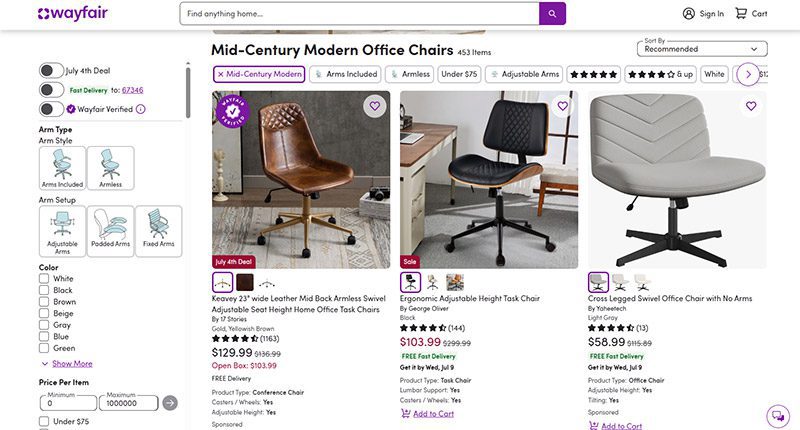
When it comes to furniture, Wayfair offers the best of both worlds. Their goods, including their mid century modern office chairs, are stylish and affordable. You can get a sturdy task chair for less than $100 or a more distinguished seat for less than $350.
MCM office chair examples: Dovray ($126), Bradford ($139), Lithonia ($133)
2) France & Son

Wayfair’s chairs are affordable, but France & Son is the perfect option for luxury shoppers. Their mid century modern office chairs are robust and sleekly designed. If you dress to impress and enjoy the finer things in life, these are the chairs for you.
MCM office chair example: Brooks ($695)
3) Houzz
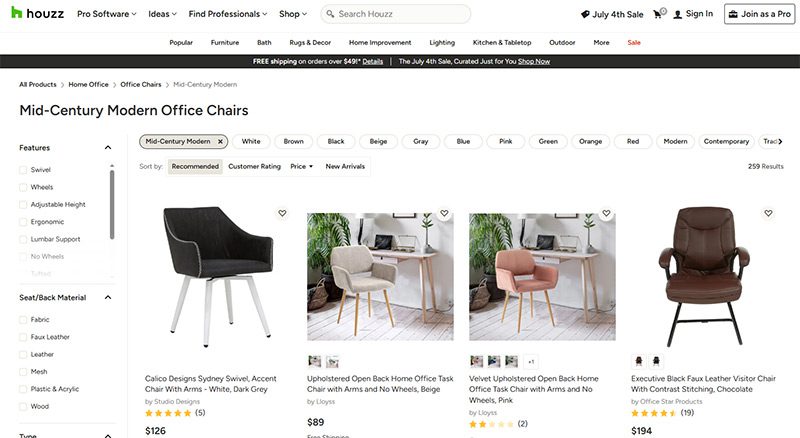
Started as a community for people to share home decor tips, Houzz has become a great ecommerce platform for finding stylish furniture. They’re more known for home decor than desk chairs, but they have plenty of great, affordable finds if you know where to look.
MCM office chair examples: Arvilla ($173), Rathburn ($259)
4) Laura Davidson
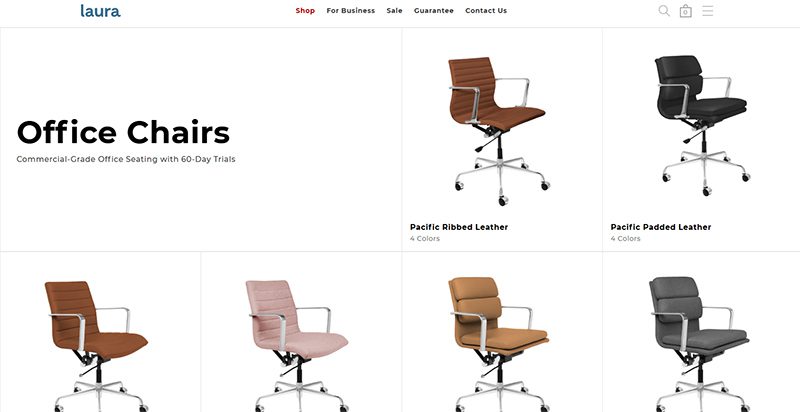
The Laura Davidson collection offers a fairly limited selection of classic office furniture. Still, there’s a reason they’re trusted by big-wigs like Apple, Disney, and Salesforce. Their chairs are sturdy and beautifully designed, reimagining classic Eames and Knoll designs.
MCM office chair examples: Rockefeller ($275), SOHO II Soft Pad ($450)
5) Icons of Manhattan
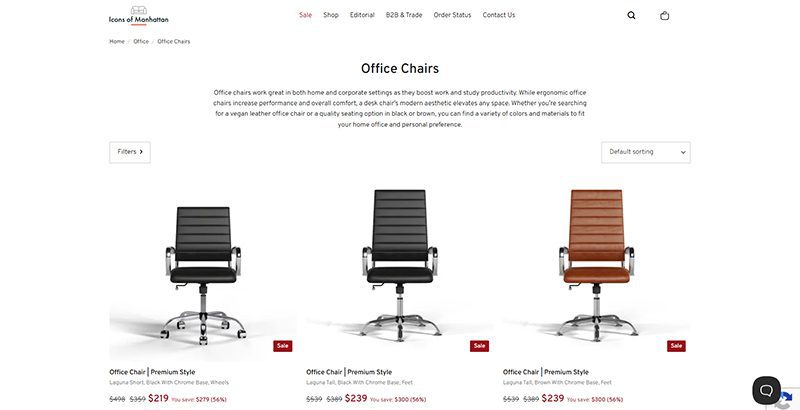
Icons of Manhattan has a simple philosophy: do one thing, and do it right. Their office chairs are handcrafted from premium materials and tailored to a mid-century modern style. If you want that Mad Men energy in your office (hopefully with a lot less angst), these are the chairs for you.
MCM office chair example: Ribbed Medium ($219)
6) Amazon
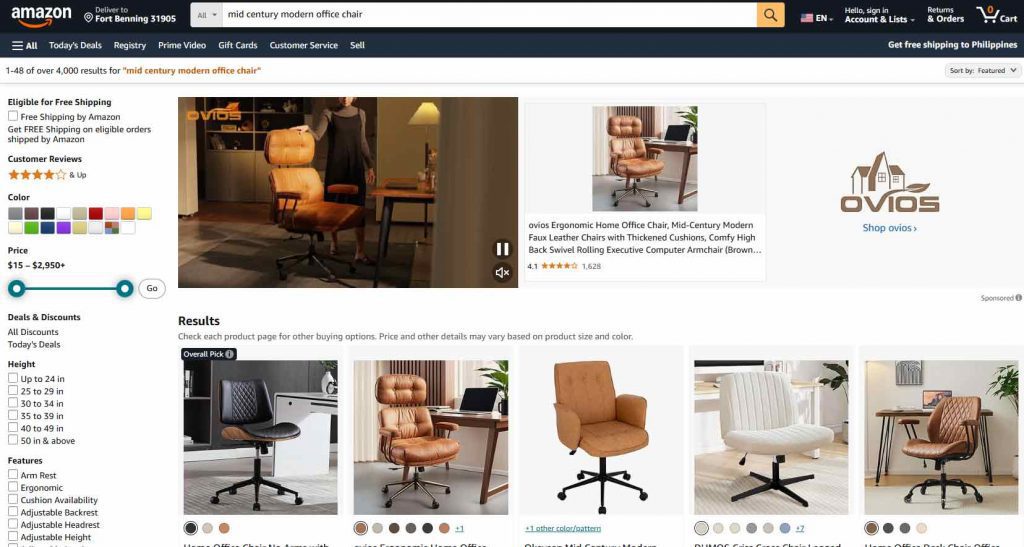
Yes, the internet’s premier shopping destination has a robust collection of mid century modern office chairs. Like with most products, their selection of seats is vast and can be hit or miss. Still, they’ve got stunning chairs available for any style, whether you care about comfort, class, or ergonomics.
MCM office chair examples: IDS Home Modern ($219), Art Leon MCM Swivel ($139)
7) AllModern
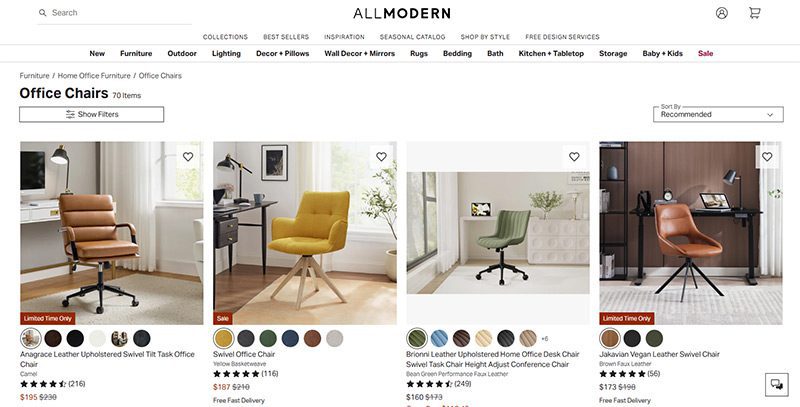
AllModern’s collection of desk chairs and other furniture truly embodies the mid century modern spirit. Their work is tight, angular, and functional above all. They’re part of the Wayfair family and they traffic in a number of modern styles, but their sleek chairs are perfect for any mid century modern space.
MCM office chair examples: Frederick ($229), Kealey ($349)
8) Overstock

Overstock is known as a one-stop shop for quality home goods at sub-wholesale prices. If you want a spiffy mid century modern office chair that won’t break the bank, they’re the first place to look. While they’re somewhat less reliable than the more upscale platforms on this list, their selection is massive.
MCM office chair example: Joseph Modern ($163)
9) Walmart
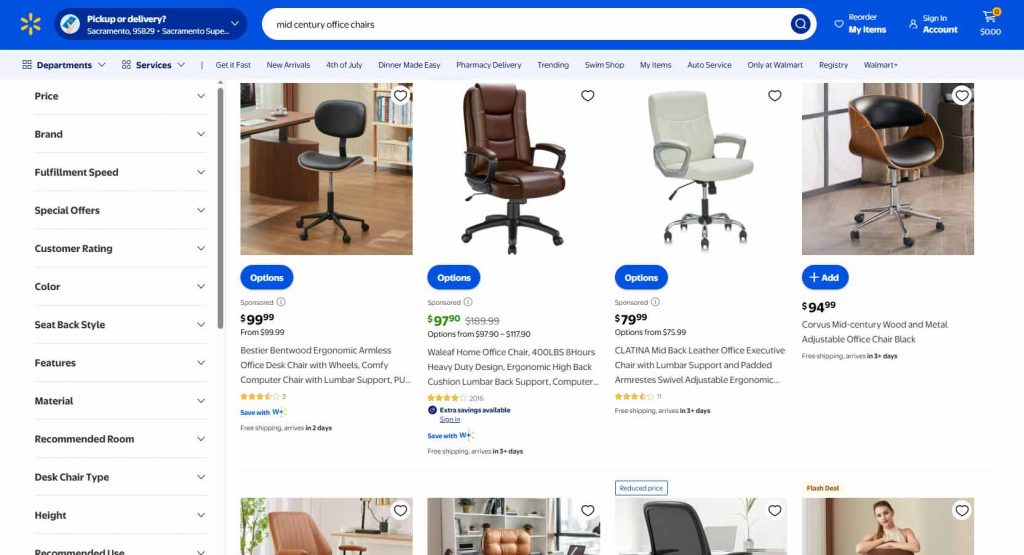
Hayneedle’s selection of mid-century modern office chairs falls somewhere between the minimal Laura Davidson and the endless Amazon catalog. Their array of mid-century designs is affordable and versatile, with chairs that match almost any style. While they may be part of the Walmart family, these chairs are anything but second-rate.
MCM office chair example: Waleaf ($97)
10) Target
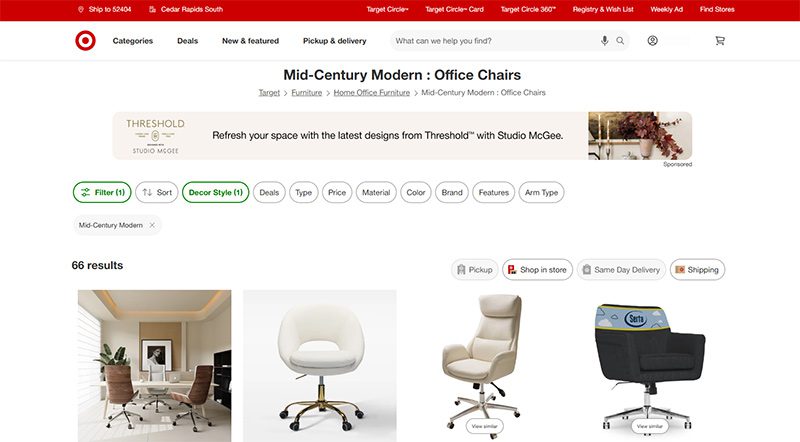
Why splurge when you can save? As usual, Target is a hidden gem, offering a sturdy selection of mid century modern office chairs for some of the cheapest prices out there. Many of the chairs they offer are from the same designers as these other stores—Christopher Knight, LumiSource, Armen Living, etc.—at reduced prices.
MCM office chair example: Lombardi ($136)

A quality payroll service is one of the most invaluable tools any entrepreneur can have. Whether you’re a small business owner or an HR manager, paying your employees on time is crucial. This makes choosing a service even more weighty, after all, it is a heavy administrative burden. The good thing is, you can outsource this duty to an online payroll processor.
According to statistics, 49% of workers begin a new job search after just two paycheck errors, and with 65% of workers living paycheck to paycheck, it’s more important than ever to ensure an efficient, effective payroll process.
These services can save you precious time and mitigate potential issues. To make it easy for you to choose, we listed the best online payroll services for 2025.
Top 5 Online Payroll Services
Gusto
Gusto is a great option for both new and experienced payroll administrators, boasting an incredibly clean user interface and a first-rate payroll setup. Gusto lets you manage your employee’s time off (vacation and sick pay), company health insurance, and worker’s comp. Gusto offers excellent mobile access, too. This allows employees to manage aspects of their Gusto profiles, view payday insights, and access Gusto Wallet financial tools.
Gusto offers four tiers of membership, the most affordable of which is the Contractor’s Only plan, which offers unlimited U.S.-based and global contractor payments, supporting more than 100 countries, plus 1099 creation and filing at a rate of $6 per person per month with no base price.
The other three are Simple, Plus, and Premium. Here’s a deeper look into each plan:
Simple
Price:
$40/mo + $6/mo per person
Plan details:
- Full-service single-state payroll including W-2s and 1099s
- Employee profiles and self-service
- Basic hiring and onboarding tools
- Gusto-brokered health insurance administration
- Employee financial benefits
- Payroll and time-off reports
- Custom admin permissions
- Integrations for accounting, time tracking, expense management, and more
Plus
Price:
$80/mo + $12/mo per person
Plan details:
(All Simple plan features +)
- Full-service multi-state payroll including W-2s and 1099s
- Next-day direct deposit
- Advanced hiring and onboarding tools
- PTO management and policies
- Time tracking and project tracking
- Workforce costing and custom reports
- Team management tools
- Full support
Premium
Price:
Bespoke pricing, reach out for a personalized quote
Plan details:
(All Plus plan features +)
- HR Resource Center
- Compliance alerts
- Access to certified HR experts
- Full-service payroll migration and account setup
- Health insurance broker integration
- R&D tax credit discount
- Waived fees and exclusive pricing
- Performance reviews
- Employee surveys and insights
- Dedicated support
QuickBooks Online Payroll
Founded in 1983, Intuit is a California-based financial software company. Since its inception, Intuit has developed into one of the best-known providers of accounting software. Their online payroll service, QuickBooks, includes the essential features you need to run payroll.
QuickBooks offers three tiers of membership. The least expensive membership covers basic accounting features, such as invoices. For more features, check out the Essentials and Plus memberships. Each plan’s features are as follows:
QuickBooks Simple Start (2025)
- Price: $38/month for 1 user
- Best for: Freelancers and small teams with basic payroll needs
Features:
- Automated bookkeeping
- 5 free ACH bank transfers/mo for bills
QuickBooks Essentials (2025)
- Price: $75/month for 3 users
- Best for: Small businesses needing deeper financial tracking
Features:
- Includes all Simple Start features, plus:
- Recurring invoices
QuickBooks Plus (2025)
- Price: $115/month for 5 users
- Best for: Growing businesses with HR and compliance needs
Features:
- Includes all Essentials features, plus:
- AI-powered profit & loss insights
- Anomaly detection and resolution
- Budgeting
QuickBooks Advanced (2025)
- Price: $275/month for 25 users
- Best for: Established businesses with HR and compliance needs
Features:
- Includes all Plus features, plus:
- Custom user management and permissions
- Custom report builder
- Data sync with Excel
- Revenue recognition
- Forecasting
OnPay
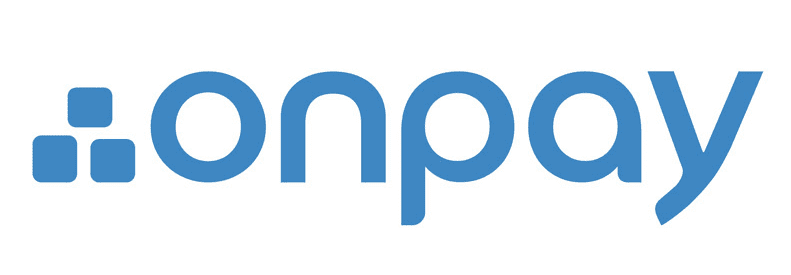
OnPay is a cloud-based full-service payroll processing system capable of running payroll according to a preset schedule, automatically disbursing wages, and calculating and withholding taxes.
OnPay can sync up with several other software your team is already using, making it easy to integrate the service into your team’s system. Another benefit of OnPays model is the simple, transparent pricing structure. No tiers; just one base rate.
Pricing:
$49/mo + $6/mo per employee
SurePayroll

SurePayroll’s award-winning service supports W-2 employees and 1099 contractors. Additionally, it handles 401(k) deductions and manages flexible spending accounts (FSA) and health savings accounts (HSA).
SurePayroll also offers a mobile app— available on both Apple and Android devices.
SurePayroll offers live support through its United States-based support team through chat, email, or phone.
Small Business Payroll
- Price: No Tax Filing: $20/month + $4 per employee, Full Service: $29/month + $7 per employee
- Best for: Small businesses and startups
Features:
- We file and deposit your federal and state taxes!
- Run payroll in 3 simple steps
- Schedule payroll to run automatically
- Unlimited payroll runs and free 2-day direct deposit
- Reports and pay stubs are available online 24/7
- Supports W-2 employees and 1099 contractors
Nanny & Household Payroll
- Price: Full-Service Household, $39/month, includes 1 employee, $10 per additional employee
Best for: Homeowners
Features:
- Signature-ready Schedule H
- We file & deposit your federal and state taxes!
- Run payroll in 3 simple steps
- Schedule payroll to run automatically
- Unlimited payroll runs and free 2-day direct deposit
- Reports & paystubs available online 24/7
- Supports W-2 employees & 1099 contractors
Be sure to choose a payroll service that works for your business, and provides you with the peace of mind that comes with a reliable bookkeeping system. Your employees will thank you.

Merck is currently in talks to acquire Seagen, a biotech company. The Wall Street Journal reports that the transaction is valued at $40 billion. And what happens if Merck acquires Seagen, and how would this acquisition benefit cancer research and treatment? Read more about the Merck Seagen buyout here.
Merck Seagen Buyout
Merck and Seagen are still deciding on their share prices. So far, talks have yet to reach an agreement on $200 per share. Both companies want to settle and finalize their deals before Merck announces its quarterly earnings on July 28. At the time of writing, Seagen’s stock was at $176.19.
With an estimated market value of $235 billion, Merck is looking to expand its presence in the cancer treatment space. The Merck Seagen Buyout could play a major role in that strategy. Since Seagen specializes in targeted cancer therapies, the acquisition would give Merck access to a broader range of oncology products.
Shareholder reactions to the new deal are overwhelmingly positive, and the stocks have been up since talks about the deal have been made public.
But this is not the first time that Merck and Seagen have made the news. Back in 2020, they collaborated because of cancer treatments. Seagen has a drug conjugate (ladiratuzumab vedotin) which would be used in conjunction with Merck’s Keytruda.
Merck reveals that Keytruda is its highest-selling product. It’s immunotherapy for cancer.
And this deal could help Merck offset the possibility of reduced sales because it will lose patent protection in 2028.
As promising as this deal is, there could be scrutiny from antitrust officials since there might be a litigation case from the Federal Trade Commission or Justice Department.
The Seagen buyout isn’t the only deal Merck has made recently. They’ve been busy closing another deal, but with Orion too.
Seagen
As a cancer biotech company, Seagen has therapies to ensure that patients benefit from the treatment and reduce any adverse side effects. Their treatments involve the therapy attacking tumors with toxins.
Merck partnering with Seagen isn’t a bad idea considering that Seagen made $1.4 billion in sales in 2021, most of it coming from Adcetris and Padcev (a treatment for urothelial cancers).
Merck-Orion Deal
In the middle of the Merck Seagen Buyout, Merck has recently partnered with Orion for the ODM-208 and other drugs. These drugs are related to the production of steroids. Orion found how it can combat hormone-dependent cancers and further developed this inhibitor.
Their deal includes that they should develop ODM-208 and promote it to the public together. And Orion will receive a $290 million payment from Merck.
Although they’re co-developing and marketing the new inhibitor, Orion will oversee the manufacturing side.
Co-developing the ODM-208 can help Merck with its current research and treatments for prostate cancer. President and CEO of Orion, Timo Lappalainen, says that this partnership will benefit Merck’s goals of treating cancer worldwide.
Other Ventures: Merck’s Role in the Pandemic
You may have heard about COVID-19 pills, which are a form of treatment for those diagnosed with mild to moderate COVID-19. Merck introduced an antiviral COVID-19 pill to the public. The name: Molnupiravir.
The COVID-19 pill is not a replacement for a vaccination. Instead, it stops the replication of the COVID-19 genetic code and keeps the patient out of the hospital. Not yet FDA-approved, Molnupiravir has been authorized for emergency use since December 23, 2021.
And for other stories, read more here at Owner’s Mag!

What Is Tiktok Pink Sauce? The Viral Condiment, Explained

Did You Drop Your Smartphone in The Ocean? Here’s How to Retrieve It

Gift Guide: 25 Best Gifts for Women for All Occasions

History of the NBA: The Success Behind the Big League

Demio SaaS 2025 Review: Features, Pricing, Pros & Cons

Top 12 Uses for The Metaverse That Will Change Your Life

Top 10 Best Places to Buy a Mid Century Modern Office Chair

Top 10 Best Places to Buy a Mid Century Modern Office Chair

History of the NBA: The Success Behind the Big League

8 Best Equipment for YouTube Every Content Creator Needs

Demio SaaS 2025 Review: Features, Pricing, Pros & Cons

Did You Drop Your Smartphone in The Ocean? Here’s How to Retrieve It

Top 10 Small Business Organization Tools for 2025

Top 12 Uses for The Metaverse That Will Change Your Life
Trending
- Entertainment5 days ago
History of the NBA: The Success Behind the Big League
- Lifestyle4 days ago
Did You Drop Your Smartphone in The Ocean? Here’s How to Retrieve It
- Lifestyle5 days ago
Gift Guide: 25 Best Gifts for Women for All Occasions
- Top Stories4 days ago
What Is Tiktok Pink Sauce? The Viral Condiment, Explained




Kat
December 29, 2022 at 1:14 am
You have not done enough research on Tori, her company, her podcast, or her investing platform. If you did, you would know that she never leads with, “If I can do it, so can you.” In fact, she admits that the information she shares is not going to be readily applicable to everyone’s life, depending on their circumstances. She constantly reiterates and validates that circumstances play a gigantic role in anyone’s financial state. She also owns up to not knowing everything and regularly calls in other experts, including the CEO of Ellevest, to speak on subjects with which she is less familiar. In her podcast, she is not afraid to learn with her audience. In her book, she interviews other financial experts to provide a wider scope of understanding than she, herself, can provide. Tori does what she does to provide not her just her knowledge but to guide her audience to other sources of information, resources, and tools. The goal is to amelliorate as many people’s lives as she can, not save everyone or to make it seem like everyone can save 100K at the age of 25. Most people cannot. She knows this. Her goal is to help people do the best they can with what they have, and she speaks to women/women-presenting individuals because we are typically left out of the conversation of personal finance. She does her best to bring the conversation TO us, instead of us having to seek it out. There are many women-owned companies working towards the same goal as she is. What’s unique about Tori is that, yes, she has blown up on social media. She happens to have that skill and background, but it does not negate her objective or the fact that she is successfully bringing attention to the importance and improvement of personal finance in the lives of women/women-presenting people. The fact that she is successful on social media is strategic, not discrediting, and doing so puts her company in front of younger adults, allowing it to be in a position to help people earlier in their lives, an advantage that is lost on other conventional personal financial experts.
You said you learned about personal fincance from your mom. First, I would like to mention that you are lucky you had a parent that taught you about money. Many people do not get to learn from their parents for a multitude a reasons. Was your mother a sound financial advisor? I’m not trying to make the point that your mother was bad with money. I’m saying that at one point, she knew more than you and taught you what she knew. Tori is doing the same. In addition to doing the same, Tori has access to a network of qualified individuals who are helping her along the way. Does Tori make money off of her audience? Yes. She is providing a service and utilizing her skill set to improve lives, which has value. There is nothing wrong with being compensated accordingly, be it directly or indirectly. With that said, she also provides a substantial amount of resources, links, and advice for free on her website and in her podcast/podcast shownotes. In summary, Tori is doing great work. She has managed to run a successful business while remaining accessible, and I recommend her to anyone looking to learn about personal finance.
Derek
August 11, 2023 at 12:40 am
Her parents are rich and sent her to University Of Portland, which costs $58,000+ a year in tuition ALONE.
How is this not easy to understand? Rich white girl with no financial credibility marketing herself.
Deckela
August 26, 2023 at 4:27 am
You sound jealous and patronizing. Who do you think YOU are?!